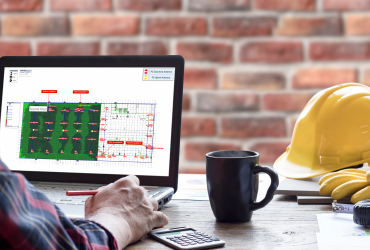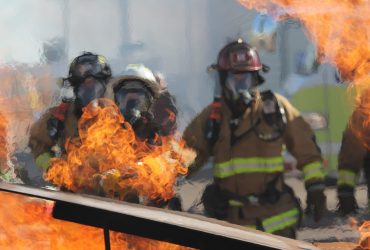Case Study 1: Near-Far Effect
Consider the case where, there are two emergency responders in the venue and both key in at the same time. Person A is right below a DAS antenna and Person B is at the Cell edge (Poor coverage). In this scenario, if the system is not channelized, the uplink gain is adjusted allowing Person A to communicate properly, but the gain in the system is not enough for Person B to communicate with the public safety tower. This is called Near-Far effect.
To remove this effect, it is essential to have channelized gain settings in the DAS system. Each individual channel (frequency) will have a different gain setting depending on the signal level. Another way to mitigate this issue is to have consistent signal level throughout the venue. This can be achieved by having higher number of antennas.
Case Study 2: Equipment Placement and Choice of Coax
While designing for a high-rise building, we were informed by the AHJ, the frequencies that the Public Safety DAS are in the UHF range. There are limited OEMs which have BDA / DAS solutions for UHF frequencies.
An OEM with UHF range BDAs was selected, but due to the large size of the venue, it was impractical to use that BDA to cover the entire venue. To reduce the losses in the system, we designed the system with high quality plenum rated coax which has 0.6 dB of loss per 100 Feet as compared to 3.5 dB of loss per 100 Feet for typical Coax cables. Changing the coax, and the position of Donor Antenna and Headend Location, allowed us to design a system that could satisfy the code requirements.
Case Study 3: Uplink Noise
It is a common misconception, higher gain equals better system performance. That is not the case in the In-Building RF world. It is essential that the system is optimized on the uplink because excessive gain will cause increased noise at the base station. High noise levels will severely impact the communication of all emergency responders served by the base station.
Consider a scenario where the base station receiver has a Noise figure of 6 dB (typical for thermal noise floor of 12.5 KHz bandwidth), and the noise floor of the receiver is -127 dBm (-133 dBm + 6 dBm). To achieve a minimum signal to noise ratio of 17 dB (SINR of 17 dB generally results in a Delivered Audio Quality DAQ of >= 3.0), the uplink signal from the portable device should be -110 dBm. In this example, the base station is around 10 Miles from the donor site.
If a new BDA system is installed in the vicinity, the noise floor at the donor site is raised by 6 dB. Due to the increased noise floor, the link budget on the uplink should be reduced by 6 dB to keep the SINR at 17 dB. The only way the link budget can be reduced is by making reducing the distance by half because the signal strength is inversely proportional to square of the distance. Communication between the portable and the base station will be impacted if the portable is between 5 and 10 miles from the base station.
In a typical Metro area, there might by multiple BDA system all feeding off a single public safety base station. In this scenario, even if the uplink of the DAS system is optimized to 15 dB below site noise floor of -115 dBm, due to too many BDAs, the effective noise floor at the base station might increase above -115 dBm. The best solution is to use Class A amplifier which have features like sharp filters, channelized gain, filters with squelch threshold, where the channel remains quiet until a strong signal is detected. In a Class B BDA, all frequencies within the set passband are transmitted continuously, which means Class B BDA is amplifying and transmitting noise continuously.



